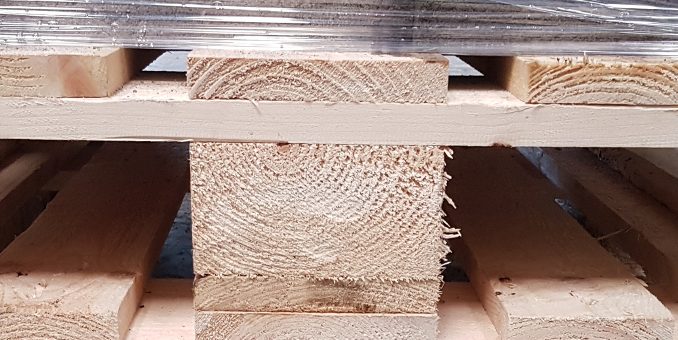
As I write this, the first Covid vaccines are being delivered in the UK. Somewhere along the line you can be sure that this achievement of logistics involved wooden pallets, or wooden packing cases. It is a fair bet to say this about anything really, since 95% of goods are shipped on wooden packaging.
Every year, some 1.5 billion wooden pallets are produced worldwide – but pallets are far from the simple, short-lived*, low-value wood product that many imagine. In 2019, in the UK, there were almost 45 million new pallets made, but more than that, 48 million, were repaired and put back into service [see TIMCON press release 30 January 2020].
For sure pallets don’t cost a lot of money – but they do a very valuable job and a bad pallet, if it messes up your system, can be a very expensive problem indeed. Which brings me to the topic of this post.
From the 1st January 2021, it will be a legal requirement for all wood packaging material moving in both directions between UK and the EU (and from GB to NI) to be compliant with a treatment and mark as specified in the International Standard for Phytosanitary measures No 15 (ISPM15). This adds a new requirement for some 60 to 100 million pallet trips per year.
While the risks posed for plant health (of hitchhiking pests and diseases) have not changed as a result of Brexit, the way they are controlled will be (irrespective of any deals currently on the table). Non-compliance may result in fines, possibly destruction of the wood packaging at the importers expense, and – more costly – might result in the goods carried being turned back. If this affects your business you should certainly go to TIMCON’s website to get the latest information.
ISPM15 compliance means heat-treatment or fumigation – although the first is the usual way, being relatively simple (56 C for 30 minutes) except for a couple of issues:
- The huge number of pallets needing treatment, and the fact that many of them have goods on top of them.
- Heat treatment can bring about some other pallet quality issues.
The industry, through TIMCON, has been working hard to solve on the former problem since this consequence of Brexit was known, with 75% of the sector now confident they can meet their customers’ requirements.
The second problem is something our research already helped with.
The story begins in 2013, which for some reason, turned out to be an exceptionally difficult year for stain and mould issues for wooden pallet manufacturers (not just in the UK and Ireland but also across Europe). TIMCON decided to investigate the problem in more detail, and approached Ivor Davies here at Edinburgh Napier University (now a senior lecturer in the Graduate School for the Environment at the Centre for Alternative Technology).
It became quickly apparent that, while there had been a great deal of work done on kiln drying of timber, there had been nothing done on the specific case of kilning green pallets. Ivor’s investigation, which involved some 15 thousand moisture readings, resulted in a report that contained working practises that enabled pallet manufacturers to advise customers that they were in a position to give 100% guarantees regarding no stain or mould.
From this work TIMCON produced two documents – ‘best practice for manufacturers’ and ‘best practice for users of kiln dried pallets’. The results were also shared with manufacturers in European and USA through TIMCON presentations.
As with many research projects that prevent problems, it is difficult to put a monetary value on what the impact was – since we do not know what costs would have been incurred otherwise. However, the benefit to manufactures supplying the pharmaceutical, and food and drink sectors has been described as ‘invaluable’. Not only has it helped with customer satisfaction, but it has helped the wooden pallet industry rebut claims that they only way to prevent stain and mould is to use alternatives like plastic pallets.
As we approach the 1st January Brexit deadline the work has been further gaining in importance because the heat treatment process for ISPM15 can increase the likelihood of staining and, subsequently mould. While these are not plant health issues, they are clearly not acceptable for many pallet using sectors.
With thanks to John Dye, President of TIMCON for providing background information. And of course thanks to Ivor for doing this work.
* We learned from John Dye’s presentation at the Wood Technology Society (of IOM3) winter webinar on Brexit perspectives that the pallets used in whisky maturation can last a lifetime (citing an example of one he noticed that was 50 years old) and that pallets used in pallet pools can be 25 to 30 years old (albeit with some periodic repairs). There is no such thing as a single use pallet as they all have the potential to be used again.

Leave a Reply
You must be logged in to post a comment.